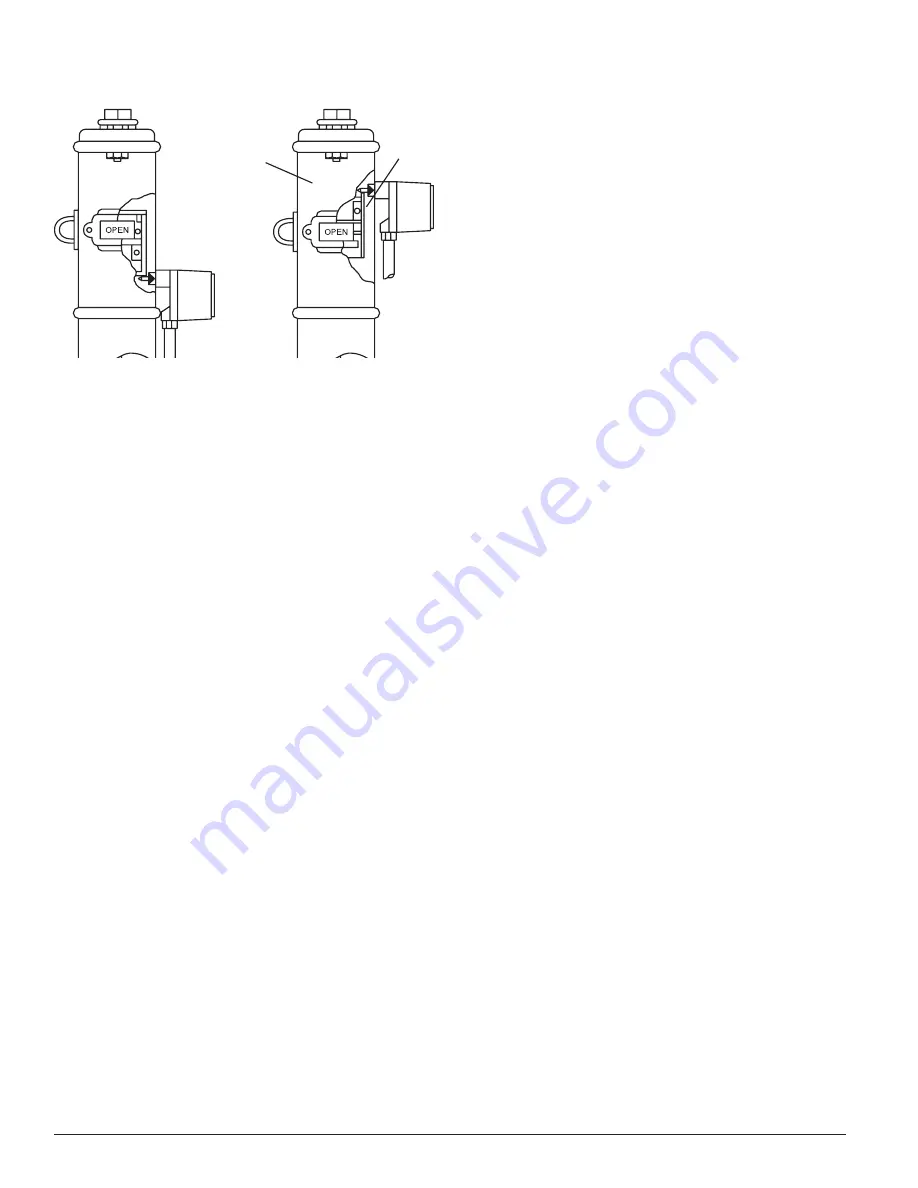
Section 1
Installation Instructions For Post Indicator Valves
1. There are two types of post indicator valves - rising flag
and falling flag. In a rising flag installation, the PIBV2A
mounts below the target assembly, as shown in Figure 2A.
Closing the valve raises the target assembly and releases the
actuating lever on the PIBV2A. In a falling flag installation,
the PIBV2A mounts above the target assembly (Figure 2B).
Closing the valve lowers the target assembly and releases the
actuating lever on the PIBV2A.
The PIBV2A is set for falling flag installation. If a rising flag
operation is desired, it is necessary to reverse the action of
the switch (See Section 4).
2. If the post indicator valve is predrilled with
1
⁄
2
˝ NPT mount-
ing hole, remove the plug and go to step 6. If the post indi-
cator valve is NOT equipped with a
1
⁄
2
˝ NPT mounting hole,
it will be necessary to drill and tap the hole.
3. Position the valve in the fully open position (“OPEN” should
appear in the window) and remove the head and target
assembly. In doing so, ensure that the assembly can be rein-
stalled with its original adjustment.
4. (a)In a falling flag installation (flag lowers as valve is closed),
measure the distance from the bottom of the head to the
upper surface of the target that will contact the actuating
lever of the PIBV2A. Add
3
⁄
32
˝ to this measurement and
mark the outside of the housing at that location. Drill with
a
23
⁄
32
˝ drill bit and tap a
1
⁄
2
˝ NPT thread.
(b)In a rising flag installation (flag rises as valve is closed),
measure the distance from the bottom of the head to the
lower surface of the target that will contact the actuating
lever. Subtract
3
⁄
32
˝ to this measurement and mark the out-
side of the housing at that location. Drill with a
23
⁄
32
˝ drill
bit and tap a
1
⁄
2
˝ NPT thread.
5. Replace the head and target assembly.
6. Screw the locknut onto the threaded nipple which is sup-
plied with the PIBV2A.
7. Screw the nipple hand tight into the
1
⁄
2
˝ hole in the valve and
Figures 2A and 2B:
HEAD
TARGET
Rising Flag
Falling flag
tighten the locknut against the housing to secure the nipple
in position.
8. Insert a probe into the hole through the nipple to measure
the distance from the open end of the nipple to the desired
position on the target assembly. Subtract
5
⁄
8
˝ from the dis-
tance and set the length of the actuating lever of the PIBV2A
from the end of the enclosure to this distance. Tighten the
screw which holds the actuating lever.
NOTE: Place cover over PIBV2 to ensure that actuating lever
does not interfere with cover. If actuating lever interferes with
cover, remove lever and break off additional length at break-
away point. Repeat step 8 to re-install actuator lever. Refer to
Figure 7.
9. Close the valve 3 to 4 revolutions.
10. Install the PIBV2A onto the nipple and orient the conduit
entry down (See Figure 4). Apply pressure to the PIBV2A
and lock the set screws to secure the nipple to the PIBV2A.
11. Slowly open the valve to its fully open position. The switch
should trip as the valve opens, but not force the actuating
lever against the nipple when fully open. To check for this
condition, open the valve fully and depress the top of the
actuating cam to stretch the actuating spring further. There
should be some additional movement available. If no move-
ment is available, damage may occur to the PIBV2A actua-
tor lever. It will be necessary to adjust the flag location by
removing the head and turning the handle while the valve
stem is disengaged (refer to the valve manufacturer.)
12. After checking the fully open position to ensure adequate
clearance, close the valve slowly until the PIBV2A contacts
trip. The switches must trip within
1
⁄
5
of the full travel dis-
tance of the valve.
13. If the PIBV2A does not change states within
1
⁄
5
of the length
of travel, it may be necessary to adjust the flag up or down by
removing the head and turning the handle (refer to the valve
manufacturer.)
Section 2
Installation Instructions For Butterfly Valves
(See Figure 3)
1. Remove the
1
⁄
2
˝ NPT plug from the gear housing.
2. Loosen 2 set screws that hold the nipple on the PIBV2A and
remove the nipple.
3. Screw the locknut onto the nipple.
4. Screw the nipple into the
1
⁄
2
˝ NPT hole and hand tighten.
Tighten the locknut firmly to the housing to secure the nipple.
5. Open the valve fully and close the valve approximately 3 rev-
olutions, noting which direction the target moves.
6. Retract the actuating arm and install PIBV2A onto the nipple,
orienting the PIBV2A to trip the switch as the valve closes. If
the conduit entry is on the wrong side, it will be necessary to
reverse the action of the switch (see Section 4). Apply pressure
to PIBV2A and tighten set screws to secure the assembly.
7. Slide the actuating arm into the valve until it bottoms on the
flag, but do not tighten the screw which holds the actuating
2
I56-2481-C
4/21






















